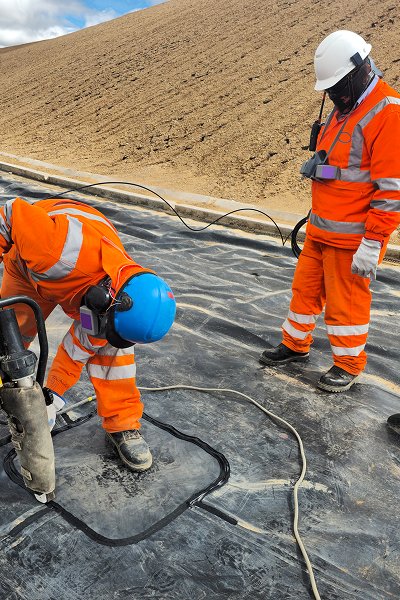What is a Geomembrane Liner ?
Geomembrane liner (Geosynthetic Liner System) usually refers to a flexible anti-seepage layer composed of one or more layers of polymer anti-seepage membrane (such as HDPE, LLDPE, PVC, etc.), and is sometimes used in combination with other materials such as geotextiles and GCL (geosynthetic clay liner) to form a composite liner structure. Its main function is to prevent liquid leakage, prevent the spread of pollutants, and to a certain extent, play a role in structural protection and chemical corrosion resistance.


Common types of classification
Depending on the raw materials, manufacturing process and structural form, geomembrane liners are mainly divided into the following categories:
HDPE geomembrane liner: the most common, with strong weather resistance and chemical stability, suitable for long-term exposure or buried conditions.
LLDPE geomembrane liner: more flexible, suitable for covering complex terrain or irregular substrates.
PVC/EVA geomembrane liner: mainly used for waterproofing of tunnels and underground structures, with good softness and welding performance.
Composite geomembrane liner: composed of geomembrane and non-woven geotextile, it has both anti-seepage and anti-puncture functions.
The core anti-seepage mechanism of geomembranes
Extremely low permeability coefficient - the basic principle of anti-seepage
The most essential anti-seepage mechanism of geomembranes is that the material itself has an extremely low permeability coefficient, which is much lower than that of natural soil, gravel layers or other artificial layers. High-molecular materials such as high-density polyethylene (HDPE) and linear low-density polyethylene (LLDPE) are highly crystalline polymers in structure, with tightly arranged molecular chains and no obvious gaps inside, so liquids cannot penetrate through the molecular structure.
Usually, the permeability coefficient of HDPE geomembranes can be as low as 10⁻¹³ ~ 10⁻¹⁵ cm/s, almost achieving the goal of "zero leakage". Compared with natural anti-seepage materials such as clay, the performance of geomembranes in permeability control has improved by several orders of magnitude..
Material continuity and integral welding - complete sealing without loopholes
Another major advantage of the anti-seepage effect of geomembranes is that they can form a continuous and complete overall structure through hot melt welding or extrusion welding, without natural cracks or gaps, effectively avoiding the emergence of "weak links".
Hot wedge welding: two pieces of geomembranes are heated to a molten state and then pressed together to form a high-strength weld;
Extrusion welding: fill the connection gap with extruded material (same polymer) to seal the seam and enhance local strength.
Multi-layer composite structure - improve overall anti-seepage ability
In actual engineering, geomembranes are often used in combination with other geosynthetics, such as:
Geotextile: provides isolation, drainage, and anti-puncture protection;
GCL (geosynthetic clay liner): with bentonite as the core, it swells when exposed to water to form a secondary closed defense line;
Drainage net (Geonet): assists in draining seepage water and reducing water pressure on the membrane surface;
Concrete or mortar layer: as external protection in important structures.
Chemical inertness and anti-aging performance - ensuring long-term sealing
Geomembranes usually use high molecular polymers (such as HDPE, LLDPE) with excellent chemical corrosion resistance. They have good chemical inertness and can resist the erosion of most acids, alkalis, salts, oils, and organic solvents to maintain the stability of the membrane. In addition, modern high-quality membrane materials generally add additives such as UV stabilizers, antioxidants, and carbon black particles to significantly improve their anti-aging properties, allowing them to maintain a sealing effect for decades in surface or semi-buried environments.
Application Scenario
Artificial lakes and landscape water bodies
Application features:
Emphasis on long-term water retention performance of water bodies;
Prevent water bodies from seeping into the ground and causing vegetation damage;
Requires good flexibility and aesthetics;
High requirements for UV resistance (exposed environment).

Landfill anti-seepage system
Application features:
Requires extremely high anti-seepage performance to prevent leachate from polluting groundwater;
Strong acid and alkali corrosion resistance;
Lifespan must be more than 30 years;
Works together with detection, drainage, and gas collection systems to form a complete environmental protection system.
Structural composition:
Geotextile + GCL + HDPE geomembrane + drainage net + geotextile;
HDPE membrane is used as the main anti-seepage layer.

Geomembrane liner anti-seepage engineering materials, with excellent anti-seepage performance, corrosion resistance and durability, have become the strict environmental protection standards for landfills in the fields of water conservancy projects, environmental governance, industrial pollution control, etc., and various complex engineering scenes such as artificial lakes, chemical pools, and tailings ponds. The material performance, structural combination methods and construction technology of geomembranes are also constantly upgraded. Whether it is a single-layer HDPE membrane, a composite GCL system, or a combination with drainage nets, geotextiles and other materials, its application solutions are developing towards higher standards, longer life, and more environmentally friendly directions.


